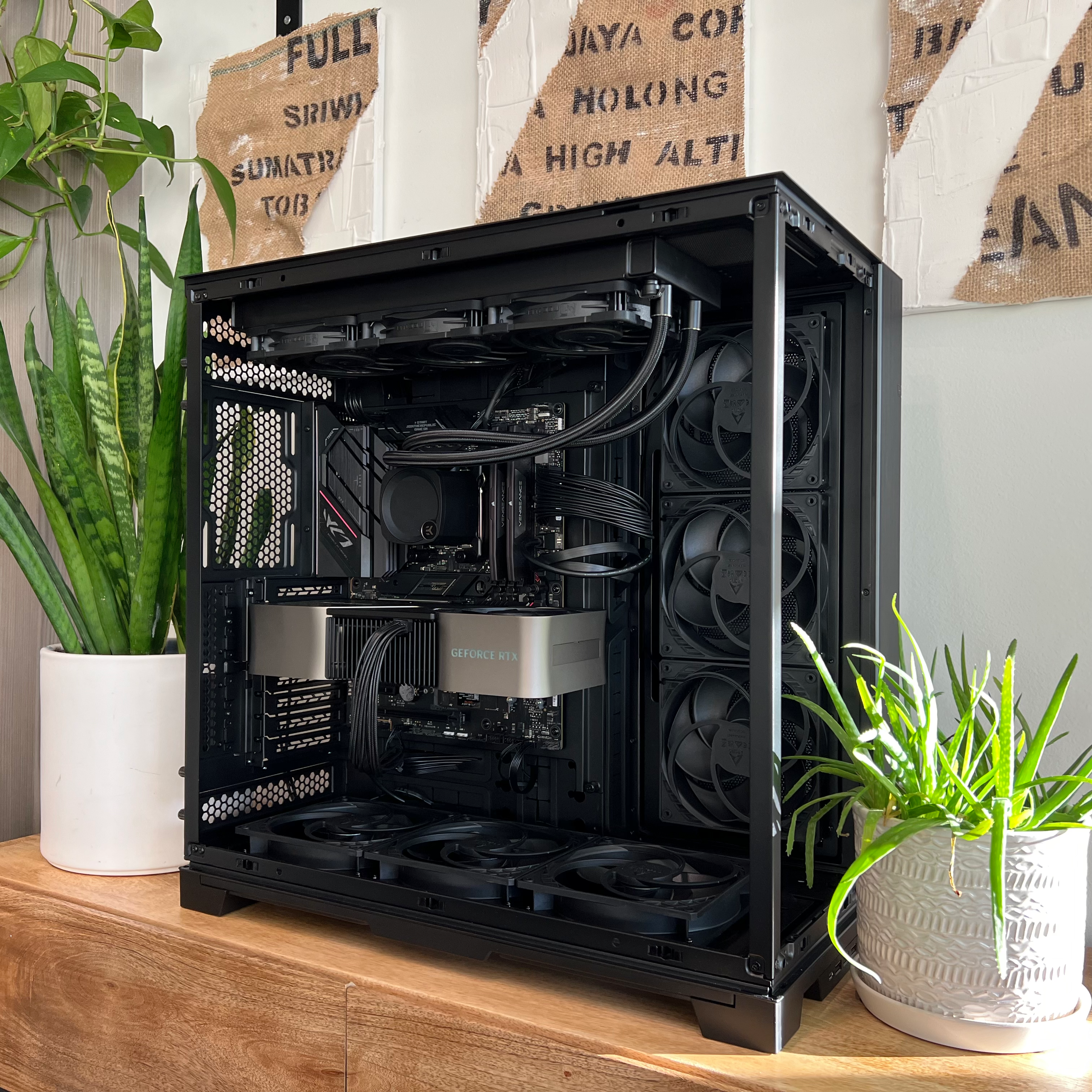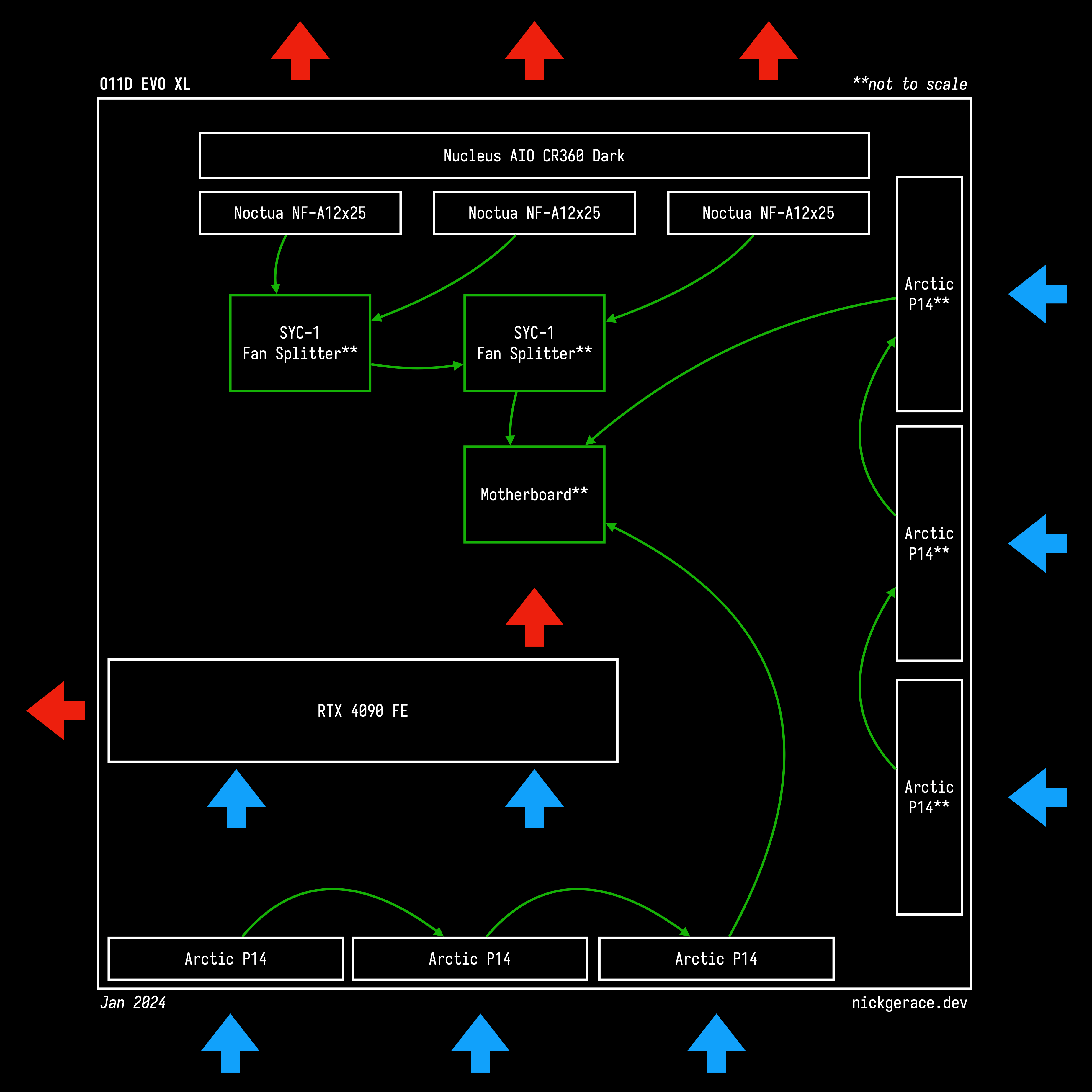I finally and recently finished my personal desktop upgrade that began in July 2022. Let’s talk about it in this iteration of the Hardware and Graphics series.
This is it: an Nvidia RTX 4090 GPU and an AMD Ryzen 7 7700X CPU inside of a Lian Li O11D EVO XL case.

Knowing that new CPUs and GPUs were around the corner, I decided to upgrade my desktop PC with a full refresh in July 2022. I started with some fan upgrades and a case swap, but the first major upgrade focused on the CPU. I upgraded to an AMD Ryzen 7 7700X CPU in November 2022. I was considering the Intel Core i7 13700K/13700KF or waiting for a potential Zen 4 X3D model down the line, but I ultimately decided on the 7700X.
What led to that decision? A few things. I had been experiencing performance bottlenecks with my old CPU. There was an active Micro Center deal at the time for AM5 CPUs. The lower power draw of the 7700X was a nice bonus in comparison to the 13700K/13700KF. Finally, I believed (and still do) that while AM5 may not live as long as AM4 did, I’d likely be able to drop a future generation 3D V-Cache (“X3D”) CPU.
Now, onto the GPU. Given the subpar launches of the Nvidia RTX 40 series (“Ada”) and the AMD Radeon RDNA 3 series GPUs, I temporarily stuck it out with the CPU upgrade alone. I was bracing for impact given inflation and the 2020-2022 GPU craze, but I did not expect bad prices and questionable product placement from both product lines.
That being said, I eventually YOLO’d for the RTX 4090 FE (Founder’s Edition) in May 2023. The non-FE models were not enticing and were generally more expensive. Moreover, the RTX 4080’s pricing was egregious relative to its performance. If the RTX 4080 FE’s MSRP had the RTX 4080 Super FE’s MSRP at launch, I probably would have went with it instead of the RTX 4090 FE. Alas, Nvidia got me in the end, like they had for so many others.
With both primary components in hand, I began to evaluate how I could effectively cool them for gaming, graphics, code compilation and AI-based workloads. My focus shifted to the cooling and stayed there for many months to come.
I bounced between a few cases and CPU coolers from July 2022 and January 2024. Due to the increasing size of GPUs and increasing thermal requirements of CPUs over the past half decade or so, few of the existing cases and coolers were appealing to me. Sure, undervolting and power limiting can be effective, but I wanted to build something with headroom for future upgrades that could all-core workloads.
Ironically, I considered a small form factor build at many points in the process. Many cases performed well thermally and were beautiful. Not only that, but the SFF Gurus Discord server and r/sffpc were (and still are) some of the most active and exciting PC communities.
I was very tempted to go with the Dan C4-SFX v1… well, at least I was if I had a chance to get one. The Fractal Design Terra looked great too, but I was worried about thermal constraints. I could have went with an external radiator, like the MO-RA3, I didn’t want to. The T1 v2 was the frontrunner, but I eventually concluded that noise, thermals, radiator compatibility and big case features (e.g. removable fan and motherboard trays) were more important to me than I had realized.
After months of research, including announcements from Computex 2023 and CES 2024, I decided to make a move. At the start of 2024, I decided to appease my teenage self, and just go for a big case with maximum cooling. Moreover, I wanted a case that I could keep for a long time and potentially build a custom loop in.
Why didn’t I build a custom loop then? While budget custom loops were possible, I preferred to put some money aside for a proper loop in the future. I also loved (and still love) the Founder’s Edition cooler design and did not want to put the GPU on a waterblock. Present day CPU AIO coolers for CPUs and GPU air coolers are better than ever too. That all being said, I probably will do try building a custom loop someday, but decided to punt for this build.
With the overall direction in place, I began the case selection and fan configuration design process.
First, I decided on the case. Few mass production cases have the quality of the Lian Li O11 series. Yes, the cases are common and many consider them to be long in the tooth. However, as far as mass production ATX cases go, I cannot find another case that is nearly as flexible and well built as those in the O11 series. Not only that, but Lian Li cases come with many helpful accessories and tools, such as screw separators and GPU anti-sag mounts.
Second, I decided on the CPU cooler. I wanted to maximize CPU performance and radiator space, so I did not look at air coolers and looked exclusively at 360mm and 420mm AIOs. I decided to go with the EK-Nucleus AIO CR360 Dark. It was a 360mm option, but I chose it because I had two 120mm NF-A12x25 chromax.black.swap fans sitting around, they did not offer a 420mm model, and the AIO performed extremely well compared to existing 360mm and 420mm AIOs on the market. I bought a matching fan, though I would have also considered Phanteks T30 fans if I did not already have the other ones. It’s hard to go wrong either way.
If I had known about the incoming 420mm Arctic Liquid Freezer III, I would have waited for reviews and compared both AIOs. Alas, such is the way of PC hardware industry: there’s always something better on the way.
Third, I decided on the case fans and overall fan configuration. Christopher Flaningan’s video was a great place to start and I decided to go with six 140mm intake fans and no rear exhaust fan. Normally, I go with Noctua fans whenever I can, but I prefer the Arctic P14’s noise profile over the Noctua NF-A14’s noise profile. They are also considerably less expensive than the NF-A14s and can be daisy-chained (i.e. they do not require a Y-splitter or fan hub). That being said, I’m looking forward to reviews of Noctua’s next generation 140mm fan. Most of these points are minor, so if you go with Noctua or Arcitc, you are in good hands.
I put it all together into a design diagram to double check…

…and everything looked good! Time to build.
I went to Micro Center to pick up the O11D EVO XL with my fiancée and we could barely fit the box in the car. Of course, the case wasn’t as big as Lian Li’s monstrous V3000 Plus, but it still couldn’t fit into the mouth of the trunk. So… we strapped the case into the passenger seat and she sat in the back. It would be an understatement to say that I was thankful for her that day.
A few weeks went by, working on the build here and there as well as ordering fans, cables, etc. that I needed. After some tests with different power supplies, performing all-core CPU benchmarks, performing GPU-based realtime Path Tracing benchmarks, laying the PC on its side to move air bubbles in the AIO and fixing a noisy rear exhaust FE fan (which had been fine in the previous case), the build went to its home on a wooden plank.
One thing you might have noticed in the build picture is that I stuck with the included PSU cables from SeaSonic’s Vertex GX-1000 power supply. While I knew I would have been fine using aftermarket cables, the 12VHPWR connector drama and revisions to popular adapters made me hesitate. It helped that I liked the cables provided too, so I didn’t replace what wasn’t broken.
I could not be happier with the result. Since July 2022, I had been slowing chipping away at this build. Sure, it only started in full in November 2022 and was “feature complete” in May 2023, but PC builds are a bit of an artform to me. You mostly buy pre-existing parts, but there are subtleties in how it looks to you and feels to use that make it “yours” in the end.
It’s safe to say that my desktop upgrade is done. Now and forever. Well… at least until AMD Zen 5, Nvidia RTX 50 series, Intel Arrow Lake, Intel Battlemage, and AMD Radeon RDNA 4 release later this year.